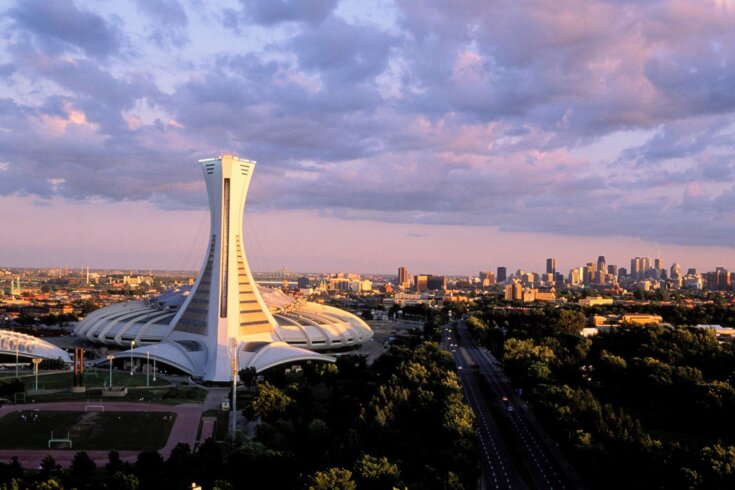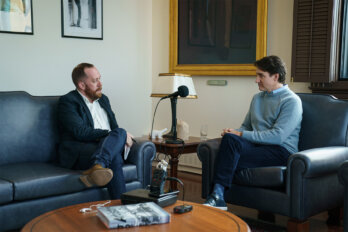Montreal’s Olympic Stadium has been called any number of things—a big white elephant, a giant spaceship. But many locals know it as the Big Owe. The name refers to the hundreds of millions of dollars the vexed landmark has cost the province over the past three decades—to construct it, maintain it, repair it, overhaul it, and now (if the Coalition Avenir Québec government has its way) slap a new roof on it.
Le Stade is undeniably a prized part of Montreal’s heritage and visual landscape. With its striking elliptical shape designed by French architect Roger Taillibert and featuring a 165-metre inclined tower that is the world’s tallest such structure, the building is best understood as a megalomaniacal bragging right. When the city beat Moscow and Los Angeles for the 1976 Olympics, then mayor Jean Drapeau boasted that the Games wouldn’t run a deficit. By the time the construction of the required facilities came to an end, the city had sunk thirteen times more money into the project than what was originally estimated, with the budget skyrocketing from $120 million to $1.7 billion. The stadium was responsible for much of those cost overruns.
It took Quebecers three decades to pay off the debt. By the time the province signed the last cheque—in 2006—the Montreal Expos, who had moved into the concrete edifice after the Olympics, were two years into being the Washington Nationals. But there is something harder to pay down: the legacy of financial dereliction, criminality, and fraud surrounding the stadium (including, as Building magazine would claim, that a “job-site union boss would be shot dead in his car years later, likely a mob hit”). A series of corruption charges, and convictions, were brought against senior officials and contractors, with Drapeau’s management criticized as incompetent and irresponsible. The Big Owe, with its ongoing maintenance issues, now serves as a cautionary tale of unchecked ambition and has had lasting repercussions on Montreal’s public projects and infrastructure development.
The debacle continues. Last month, Quebec’s tourism minister, Caroline Proulx, announced the stadium’s dated and decaying roof would be replaced for a whopping $870 million. According to the CBC, the new top would be rigid, with a transparent glass hoop that will fill the stadium with daylight and will also make the tower visible from inside. The investment, Proulx said, would make the 56,000-seat amphitheatre—still used for sporting events, fairs, trade shows, concerts, exhibitions, and even as a mass vaccination site during the pandemic—a key player in the events industry, generating economic spinoffs of about $150 million per year.
Many of the Big Owe’s woes can be traced back to its doughnut-shaped dome, which wasn’t installed until a decade after the stadium was completed. And when the roof finally arrived—retractable, made from Kevlar, and suspended by cables from the tower—it never worked properly (likely due to the design not taking into account harsh winters). The roof has already been replaced once, and the current version has thousands of tears in it. Heavy rainfall, or even a few centimetres of snow, renders it unsafe. There have been a few close calls, with chunks of the roof falling in the 1990s and a partial collapse in 1999.
Michel Labrecque, president and CEO of Parc Olympique, the agency managing the stadium, has passionately defended the new roof, saying installing it would be far cheaper than the estimated $2 billion it would cost to demolish and erect a new stadium. In a rare moment of political unanimity, Montreal mayor Valérie Plante, along with members of the opposition parties at Quebec’s national assembly, agreed. However, after journalists for Le Journal de Montréal uncovered the demolition estimate was based on a twenty-year-old study, and after experts noted the roof installation would likely necessitate additional investments of hundreds of millions of dollars to correct building acoustics and renovate the toilets and seats, many rescinded their support. The Quebec Liberal Party requested the project be put on hold. According to Le Journal de Montréal, Liberal MNA Marwah Rizqy warned that Quebecers risked being stuck with “a gigantic bottomless pit of expenses.”
The price tag that the CAQ has quoted to tear down the stadium is considerably higher than what other North American cities have spent on comparable work: razing the Robert F. Kennedy Memorial Stadium in Washington, DC, according to local reports, cost $20 million (US) in 2023. While the use of pre-stressed concrete and the stadium’s location above a metro station would make a demolition unusually complex, many critics side with Bruno Massicotte, a civil engineering professor, who told the Canadian Press that “the justification for the $2 billion was not presented.”
Badly burned by Drapeau’s financial arrogance, Montrealers haven’t been particularly open to Quebec premier François Legault’s grandiose plans to transform the stadium into “a positive symbol” for the province. Sports writer Jack Todd declared in the Montreal Gazette that Quebecers were being “flim-flammed.” Describing the stadium as “the Vietnam War of municipal mismanagement,” he wrote, “‘We can’t stop now because we’ve lost too many men already’ becomes ‘we can’t stop now because we’ve spent too much money already.’”
A billion-dollar crown for an often-empty sports stadium is a hard sell on the best of days—and these are not the best of days. Many Quebecers believe the government should be helping people get a roof over their heads and gain access to a family doctor as well as improving working conditions for teachers and nurses rather than upgrading a stadium most musicians skip on their world tours and no professional sports team wants to play in. But as Le Journal de Montréal reported, the CAQ is so intent on its plans that it refuses to even order a new cost analysis. The response—and the government’s announcement that it had already signed a contract for the work, despite widespread opposition—is typical of the CAQ’s autocratic governing style. Construction is expected to be completed by 2027.
This is a boondoggle driven entirely by nostalgia. The stadium is where the first Games ever hosted by Canada were held. It’s where US decathlete Caitlyn Jenner broke the world record. On the heels of Expo ’67, another major international highlight for Montreal, anything seemed possible.
The stadium is also where the Montreal Expos—“Nos Amours” as they’re still affectionately called—played their final game in 2004, and what, for the last twenty-eight of their thirty-six seasons, the team called home. Most baseball fans will agree the Big Owe was never a proper ballpark (it’s too cavernous, mostly sunless, and has artificial turf), but it didn’t matter. It was as hallowed and revered as a church, forever associated with memories of warm summer nights: hotdogs in the stands, the crack of Vladimir Guerrero’s bat hitting another homer. It was the feeling of something that was ours: palpably hopeful, transcending language and politics, forever connected to our youth.
But nostalgia rarely makes for good decision making. Keep the tower and repurpose it as a tourist destination. With the money saved, we can erect a better stadium serving the city’s current and future needs. Not all landmarks are sacred. When fire consumed the Notre-Dame cathedral, they raced to replace the roof; Montreal’s Olympic Stadium is not Notre-Dame.
Correction, March 26, 2024: An earlier version of this article stated that Nadia Comaneci scored a perfect 10 at the Olympic Stadium. In fact, she did so at the Montreal Forum. The Walrus regrets the error.






